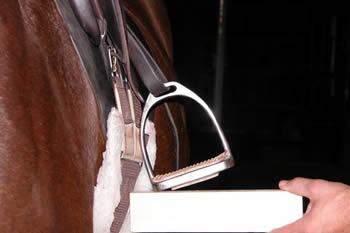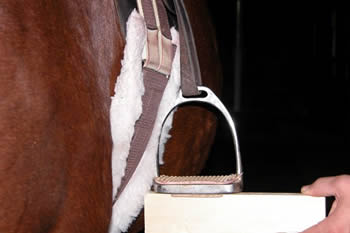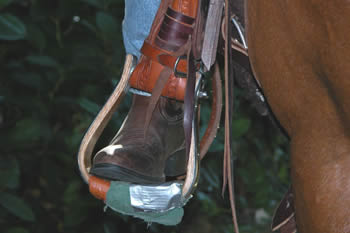Do your feet curl in the stirrups? Do you have trouble keeping them flat on the stirrup tread? Do you feel unstable through your legs and feet? Do you have ankle and foot pain during or after your ride? Does your boot jam against the outside branch of the stirrup in an attempt to find support? Whether you ride Western or English, the answer to these problems may be your saddle or your conformation. Here’s a quick tip on how to check if either of these are the cause of your foot issues and what you can do solve it.
If you have ever had a pair of ski boots adjusted to your feet you might remember that the clerk shimmed your boots until you were in a neutral stance, your alignment went from the center of the boot through the center of your knee. This adjustment compensates for knock-knees or bowed legs and any differences between your two legs. The result is that the ski is perfectly flat to the snow and you have maximum stability and support when the ski is flat.
Riding is not unlike skiing in that you want your foot flat on the stirrup to give you maximum stability and support. However, just like skiing, individual variation (differences in each person and in your two legs) can hamper this feeling and deprive you of a solid foundation. In addition to your own conformation, the saddle may be the cause for a less than ideal flat stirrup for your foot to rest on.

First check your equipment. Look at each stirrup from the front. Is the tread of the stirrup level or angled? If you have a Western saddle I can almost guarantee that the stirrup will be angled. This is due to the effect of twisting the leather to make the stirrup is perpendicular to the horse. When you twist a flat plane (stirrup leather) the plane is no longer parallel to the ground. The inside of the stirrup will be lower than the outside. The wider the leather the more the angle created. Rolling the stirrup leather (buckaroo roll) does not prevent angling. This isn’t a problem with English leathers because they are so narrow.
English stirrups can become angled if the horse is very round shaped and the leathers are very short and/or the rider has a round thigh. In this case the stirrup does not hang below the curve of the horse’s barrel. Thus the stirrups are pushed out at angle.

Regardless of whether the cause is your conformation or your saddle (or both) the solution is basically the same. You need to shim the stirrup in order to create a place for your foot that will put you in a neutral stance with even contact across the entire stirrup. You will almost always have to shim Western stirrups so you don’t need to worry about your conformation. If you ride English you might want to consider your conformation if your stirrups are level.
To assess your conformation you will need the help of a friend and a plumb-bob (a weight that is suspended from a string and used as a reference line that is perpendicular to the ground). Have your assistant hold the plum-bob so that the string is centered on your kneecap and observe if the bob hangs centered over your 2nd toe or to the left or right. (If you try to look you will interfere with the test.) If it is centered you don’t need any shims. If it is to the left or right you will need to shim your foot (on the outside or inside) until the bob hangs over your 2nd toe. I use pieces of cardboard and layer them until I find the right amount to line up the center of the knee with the 2nd toe. Carefully take the pieces of cardboard and place them in the appropriate location on each stirrup tread. Then use latex or vet wrap or duck tape to hold them in place.

The same process of using pieces of cardboard can solve your saddle problem. If the stirrup is angled lower on the inside (nearest the horse) layer cardboard on the tread until it is level. Test ride your stirrups adding or subtracting cardboard until you find a comfortable amount. You will know if you have the right amount of cardboard because suddenly your feet will feel flat and you will be more secure in the saddle.
Use this Murdoch Minute as a ‘body position self-check’ to establish a solid base of support. Experiment with shimming your stirrups until you find a supportive feeling. Leveling out your feet will improve your comfort level and your ability to communicate with your horse. And remember – enjoy the ride!




